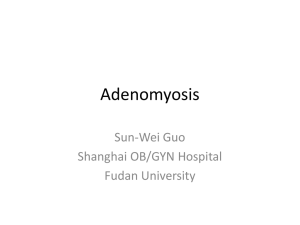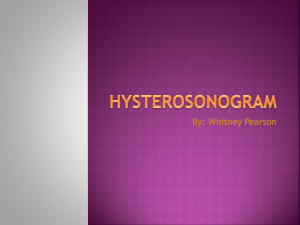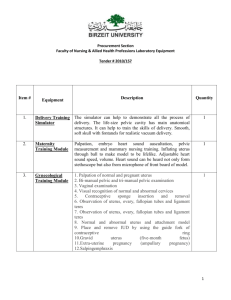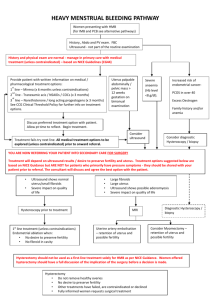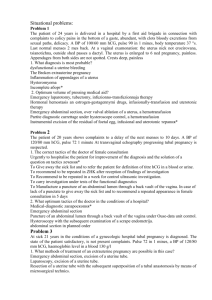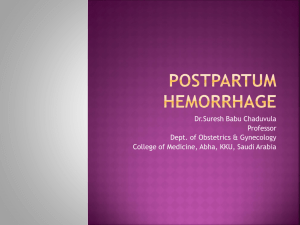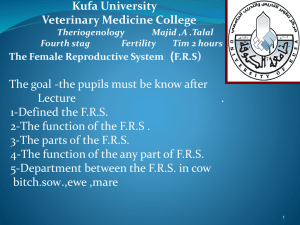15 cases clinical analysis of wedge
advertisement
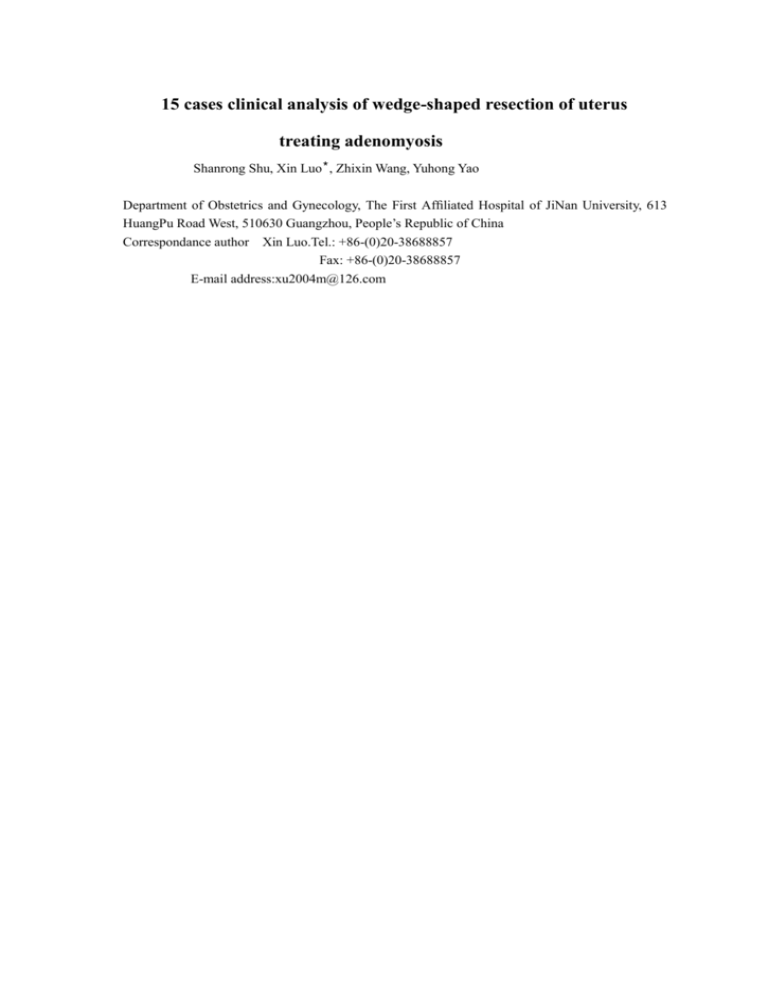
15 cases clinical analysis of wedge-shaped resection of uterus treating adenomyosis * Shanrong Shu, Xin Luo , Zhixin Wang, Yuhong Yao Department of Obstetrics and Gynecology, The First Affiliated Hospital of JiNan University, 613 HuangPu Road West, 510630 Guangzhou, People’s Republic of China Correspondance author Xin Luo.Tel.: +86-(0)20-38688857 Fax: +86-(0)20-38688857 E-mail address:xu2004m@126.com Abstract Objective: To investigate the improvement of dysmenorrhea and menorrhagia after wedge-shaped resection of uterus. Methods: The clinical data of 15 patients who experienced wedge-shaped resection of uterus for adenomyosis were retrospectively analyzed from September 2009 to October 2012. Results: All operations were successful, no serious complication occurred. 13 patients had significantly decreased menstrual flow and 2 patients had no menstrual after surgery. 9 patients with moderate dysmenorrhea had minor pain after surgery, only 1 patient still experienced moderate pain in the 4 patients who had severe dysmenorrhea. Conclusions: The wedge-shaped resection of uterus is a safe and effective procedure to significantly reduce menorrhagia and alleviate the extent of dysmenorrhea, which is a promising alternative for patient who suffered from dysmenorrhea and menorrhagia for adenomyosis. Keywords: dysmenorrhea; menorrhagia; adenomyosis; wedge-shaped Introduction: Adenomyosis is common in women of childbearing age. The signs and symptoms include progressive dysmenorrhea, menorrhagia, abnormal uterine bleeding, enlarged uterus, dyspareunia, and infertility, which can seriously affect the patient’s quality of life. Currently, the treatments mainly include pharmacotherapy, such as oral contraceptives, nonsteroidal anti-inflammatory painkillers, progesterone, Gonadotropin-releasing hormone analog (GnRHa) and surgery [1] . Drug treatment can relieve the symptom in short-term, but drug withdrawal usually results in the recurrence. Although adenomyosis mainly occurs in multiparous women, those women still want to preserve uterine. What’s more, the newly recognized theory about endometriosis is eutopic endometrium determinism[2]. So how to clear away eutopic endometrium but preserve uterus become the focus of many gynecologist. Wedge-shaped resection of uterus is the procedure in which the uterus body and most endometrium are deleted, and the remnant uterus muscle is sutured. The advantage of this procedure is retaining uterine artery ascending branch, which can delay the occurrence of menopause symptoms. The aim of the present study is to analyze the improvement of symptoms after the wedge-shaped resection of uterus, and to explore whether wedge-shaped resection of uterus is a promising treatment for adenomyosis. Subjects and Methods Patients 15 patients were admitted in our study during September 2009 to October 2012. All of them underwent wedge-shaped resection of uterus, and pathological examination verified adenomyosis. The age of patients ranged from 32 to 42 years old, the mean age was 33.2±3.2 years old. All the patients were multi-parous women, 10 patients gave birth to two children. 6 patients had minor uterus myoma, 2 patients had ovary endometriosis. After surgery, all the patients were followed up for 7 to 12 months. No patient had recurrent lesion. Surgery method The uterus was pulled outside of the abdominal incision. This technique involves :Recognition of the lesion's location and borders by inspection and/or palpation. Longitudinal incision of the uterine wall along the adenomyoma. Sharp and blunt dissection of the lesion with scissors to the removal of a fibroid and partial normal myometrium. Thus, we resected the main body of uterus and most endometrium from anterior and posterior wall of uterus (Figure.1), which appeared an inverted triangle, the vertex was the endocervix, the baseline was the uterus fundus. Then we sutured the remnant uterine wall in a seromuscular layer or in two or more layers and suturing of the endometrial cavity with absorbable suture when necessary. In some patients, we also separated the pelvic adhesion, stripped ovary chocolate cyst and excised minor myoma. Outcome measurements The degree of dysmenorrheal (pain) was assessed using the visual analogue scale. The left end of the scale was set at 0 (no pain) and the right end of scale at 100 (intolerable pain). The degree of pain was self-reported by patients. For menstrual flow, the number of sanitary napkins used was counted. Follow up We called the patients to ask for the situation of dysmenorrheal relief and menstrual flow, also, we advised the patient to take B ultrasonic examination regularly to find the recurrence. Statistical analysis The SPSS 13.0 software package was used for statistical analysis. P<0.05 was considered statistically significant. Results Operation situation All the operations were successful, no serious complication occurred. The lesion of adenomyosis ranged from 3cmX2cm to 10cmX8cm. At the same time, pelvic adhesionlysis was taken in 6 patients, ovary chocolate cyst was stripped in 2 patients, and minor myoma was excised in 6 patients. The improvement of symptoms According to the visual analogue scale, when the score was below 40, we considered the pain was mild, when the score ranged from 40 to 80, the pain was moderate, when the score was above 80, the pain was sever. In our study, before the operation, 9 patients had moderate dysmenorrheal, 4 patients had severe dysmenorrhea, only 2 patients did not experience dysmenorrhea. After operation, 9 patients undergoing moderate pain had mild pain, the remission rate was as high as 100%. In the 4 patients who suffered from severe dysmenorrheal, only 1 patient still experienced moderate pain. All patients suffered from menorrhagia. The used napkins was counted, as shown in table.1, 15 patients all used a great many napkins, which was as high as 50 piece per menstrual cycle. After operation, the menstruation flow was significantly decrease, meanwhile, 2 patients had no menstrual flow after operation. B ultrasonic examination The adenomyosis showed low density mass in the enlarged uterus with or without blood flow signal. In our study, the patients taking B ultrasonic examination after operation did not show that signal, instead, we found a shrunk uterus, which was shown in Figure.2 Discussion Adenomyosis is a common benign gynecological disorder affecting premenopausal women. It is characterized by the presence of ectopic endometrial glands and stroma in myometrium and hyperplasia of adjacent smooth muscle[3]. The symptoms of adenomyosis include dysmenorrhea, menorrhagia, abnormal uterine bleeding and diffuse uterine enlargement, sometimes leading to pelvic pressure and frequent urination. Hysterectomy, which eliminate the underlying source of symptoms, is the most common treatment for adenomyosis[4]. For women who wish to preserve their uterus, the alternative options include hormonal therapy[5.6], endometrial ablation therapy[7] and uterine artery embolization[8.9]. Hormonal treatment offer only temporary alleviation of symptoms and is associated with some severe side effects[10], endometrial ablation is an alternative when the depth of myometrial penetration is limited[7], uterine artery embolization has elicited mixed response[8.9]. Wedge-shaped resection of uterus removed uterus body and most endometrium, which disposes of the lesion but preserve the ascending uterus artery, so the function of ovary is not affected. This is the advantage of the procedure for it delays the occurrence of menopausal syndrome, but the weakness of this procedure is the loss of the productive function, so it is only suitable for multiparous women. Wedge-shaped resection of uterus can significantly relieve the symptom of dysmenorrhea and menorrhagia. As shown in the course of follow up period, 2 patients had no menstruation and the menstruation flow was significantly decreased for the deletion of endometrium. Also, patients who had high menstrual pain score before treatment were free of menstrual pain after surgery. They reported a significant improvement in their quality of life. All the patients had no adverse events or complication and recurrence were not recorded during the treatment or follow-up period. Our study suggests that clinical improvement in symptomatic adenomyosis is achievable with the wedge-shaped resection of uterus, which may be a promising alternative for patient who suffered from dysmenorrhea and menorrhagia for adenomyosis but still want to preserve the uterus. Conflict of interest statement None declared Acknowledgments This work was supported by Cultivating Innovation Fund of Jinan University (11614305) and Medical Research Foundation in Guangdong Province. References [1] Fraser IS: Added health benefits of the levonorgestrel contraceptive intrauterine system and other hormonal contraceptive delivery systems. Contraception. 2013; 87:273-279. [2]Benagiano G, Habiba M, Brosens I. The pathophysiology of uterine adenomyosis: an update. Fertil Steril. 2012; 98:572-579. [3]Tamai K, Togashi K, Ito T, et al. MR imaging findings of adenomyosis: Correla- tion with histopathologic features and diagnostic pitfalls. Radiographics. 2005; 25:21-40. [4] Ascher SM, Jha RC, Reinhold C. Benign myometrial conditions : Leiomyomas and adenomyosis. Top Magn Reson Imaging. 2003;14:281-304. [5] Bragheto AM, Caserta N, Bahamondes L, et al. Effectiveness of the levonor- gestrel-releasing intrauterine system in the treatment of adenomyosis diagnosed and monitored by magnetic resonance imaging. Contraception. 2007; 76:195-199. [6] Imaoka I, Ascher SM, Sugimura K, et al. MR imaging of diffuse adenomyosis changes after GnRH analog therapy. J Magn Reson Imaging. 2002;15:285-290. [7]Kanaoka Y, Hirai K, Ishiko O. Successful microwave endometrial ablation in a uterus enlarged by adenomyosis. Osaka City Med J. 2004;50:47-51. [8] Pelage JP, Jacob D, Fazel A, et al. Midterm results of uterine artery embolization for symptomatic adenomyosis: Initial experience. Radiology. 2005; 234:948-953. [9] Lohle PN, De Vries J, Klazen CA, et al. Uterine artery embolization for symptomatic adenomyosis with or without uterine leiomyomas with the use of calibrated trisacryl gelatin microspheres:midterm clinical and MR imaging follow- up. J Vasc Interv Radiol. 2007;18: 835-841. [10] Levgur M. Therapeutic options for adenomyosis: a review. Arch Gynecol Obstet. 2007; 276:1-15. Figure.1 To explain how to perform the wedge-shaped resection of uterus. a. The schematic diagram of the main body of uterus and most endometrium resected from anterior and posterior wall of uterus. b. before the operation, the uterus was enlarged. c. the main body of uterus and most endometrium was resected d. the remaining uterus e. the resected main body of uterus f. the remaining uterus was sutured Figure.2 The patients with adenomyosis took B ultrasonic examination before or after the operation. Before the operation, we found enlarged uterus with rich blood flow signal. After the operation, the uterus was shrunk. a. Before the operation, the uterus was enlarged with rich blood flow signals. b. After the operation, the uterus was shrunk with poor blood flow signals. Tab.1 The menstruation flow and dysmenorrheal of 15 patients before and after operation. Patient 1 2 3 4 5 6 7 8 9 10 11 12 13 14 15 Menstruation used napkins) pre-operation 30 25 40 40 35 30 45 40 50 40 45 35 40 45 50 flow (piece of post-operation 2 1 3 5 4 2 4 3 6 5 4 4 5 Dysmenorrheal(score) pre-operation 70 60 65 70 80 60 75 post-operation 15 10 5 16 18 10 10 65 90 8 30 95 98 70 95 25 60 8 20
